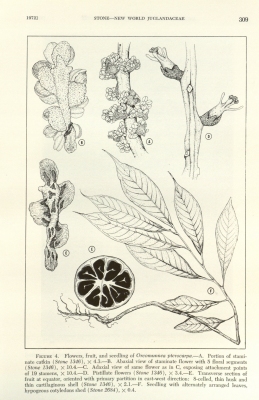Oreomunnea pterocarpa
Oerst.
Juglandaceae
Engelhardia pterocarpa (Oerst.) Standl.
Common Name:
General Information
Oreomunnea pterocarpa is a tree growing 35 metres or more tall. The bole can be unbranched for up to 15 metres, 70cm in diameter, with plank buttresses extending 2.5 metres from the base[
,
723- Title
- Annals of the Missouri Botanical Garden Vol. 59
- Publication
-
- Author
-
- Website
- http://www.biodiversitylibrary.org
- Publisher
- Missouri Botanical Garden Press; Missouri.
- Year
- 1972
- ISBN
-
- Description
- A series of botanical articles. It can be downloaded from the Internet.
].
The tree is harvested from the wild for its wood, which is traded locally.
The tree is sparse in occurrence, usually found as isolated individuals. Little is known of its regenerative capacity, although it does not appear to be strong. The plant is classified as 'Endangered' in the IUCN Red List of Threatened Species(2011)[
338- Title
- IUCN Red List of Threatened Species
- Publication
-
- Author
-
- Website
- http://www.iucnredlist.org/
- Publisher
-
- Year
- 0
- ISBN
-
- Description
- A list of plants under threat and facing possible extinction, usually with brief details of the threats and information on habitat.
].
Known Hazards
None known
Botanical References
723- Title
- Annals of the Missouri Botanical Garden Vol. 59
- Publication
-
- Author
-
- Website
- http://www.biodiversitylibrary.org
- Publisher
- Missouri Botanical Garden Press; Missouri.
- Year
- 1972
- ISBN
-
- Description
- A series of botanical articles. It can be downloaded from the Internet.
Range
C. America - Costa Rica, ?Panama, ?Mexico.
Habitat
Usually found as isolated individuals on steep hillsides in moist and wet, evergreen forests[
338- Title
- IUCN Red List of Threatened Species
- Publication
-
- Author
-
- Website
- http://www.iucnredlist.org/
- Publisher
-
- Year
- 0
- ISBN
-
- Description
- A list of plants under threat and facing possible extinction, usually with brief details of the threats and information on habitat.
,
]. Lowland, moist, non-seasonal, closed forest at elevations from 500 - 1,500 metres[
].
Properties
| Conservation Status | Endangered |
| Other Uses Rating |      |
| Habit | Tree |
| Height | 30.00 m |
| Pollinators | Self |
| Self-fertile | Yes |
| Cultivation Status | Wild |
Cultivation Details
The tree is believed to be shade tolerant[
].
Edible Uses
None known
Medicinal
None known
Other Uses
The wood is light in weight and not very durable[
]. Of fair quality, it has been used in house construction and interior finishes, and in cabinet-making[
]. However, it has been reported that live trees seem to suffer from internal decay near the base, usually spoiling the lumber[
].
Propagation
Seed -
If you have any useful information about this plant, please leave a comment. Comments have to be approved before they are shown here.


 Useful Tropical Plants Database 2014 by
Ken Fern,
web interface by
Ajna Fern
with help from
Richard Morris.
Useful Tropical Plants Database 2014 by
Ken Fern,
web interface by
Ajna Fern
with help from
Richard Morris.